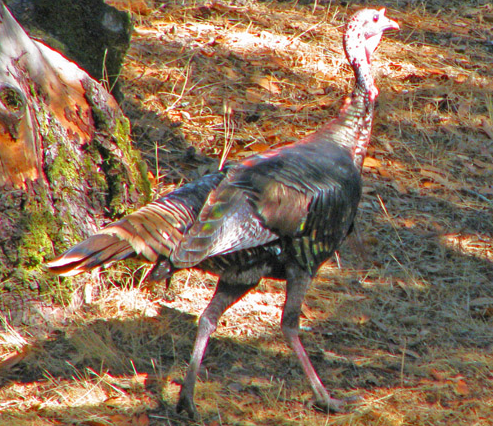Wild Turkey
Meleagris gallopavoSummary 6
The Wild Turkey (Meleagris gallopavo) is native to North America and is the heaviest member of the diverse Galliformes. It is the same species as the domestic turkey, which was originally derived from a southern Mexican subspecies of Wild Turkey (not the related Ocellated Turkey). Although native to North America, the turkey probably got its name due to the domesticated variety being imported to Britain in ships coming from the Levant via Spain. The British at...
Geographic range 7
Wild turkeys (Meleagris gallopavo) are one of the most widely distributed game bird species in North America. They are found throughout most of the eastern United States, and in pockets throughout the western United States. They are also found in parts of northern Mexico, particularly in the Sierra Nevada mountains. Wild turkeys have been introduced to Germany and New Zealand.
Biogeographic Regions: nearctic (Native ); palearctic (Introduced ); australian (Introduced )
Iucn red list assessment 8
Red List Category
Red List Criteria
Version
Year Assessed
Assessor/s
Reviewer/s
Contributor/s
Justification
Fuentes y créditos
- (c) Per Verdonk, algunos derechos reservados (CC BY-NC), http://www.flickr.com/photos/7551546@N08/3038308796
- (c) Mary Keim, algunos derechos reservados (CC BY-NC-SA), http://farm6.static.flickr.com/5250/5352246869_62ce7fb879.jpg
- (c) 2002 California Academy of Sciences, algunos derechos reservados (CC BY-NC-SA), http://calphotos.berkeley.edu/cgi/img_query?seq_num=118191&one=T
- (c) Gary Owens, algunos derechos reservados (CC BY), http://farm5.static.flickr.com/4022/4360679764_0f0463697d.jpg
- (c) c michael hogan, algunos derechos reservados (CC BY-NC), subido por c michael hogan
- (c) Wikipedia, algunos derechos reservados (CC BY-SA), http://en.wikipedia.org/wiki/Meleagris_gallopavo
- (c) The Regents of the University of Michigan and its licensors, algunos derechos reservados (CC BY-NC-SA), http://eol.org/data_objects/18657672
- (c) International Union for Conservation of Nature and Natural Resources, algunos derechos reservados (CC BY-NC-SA), http://eol.org/data_objects/28203843










